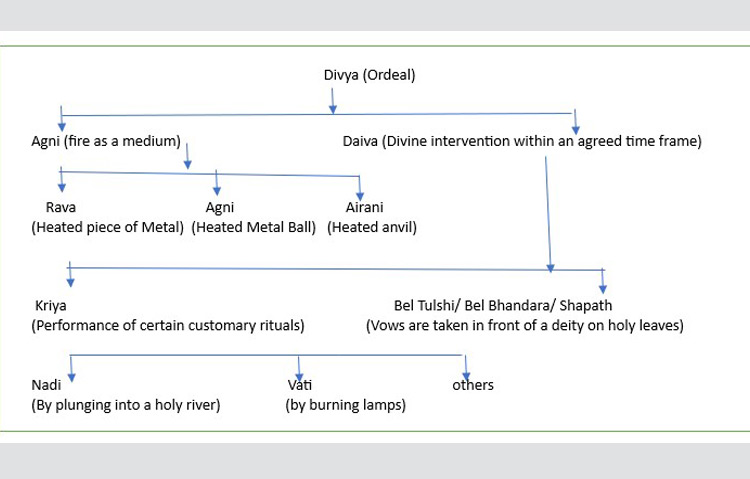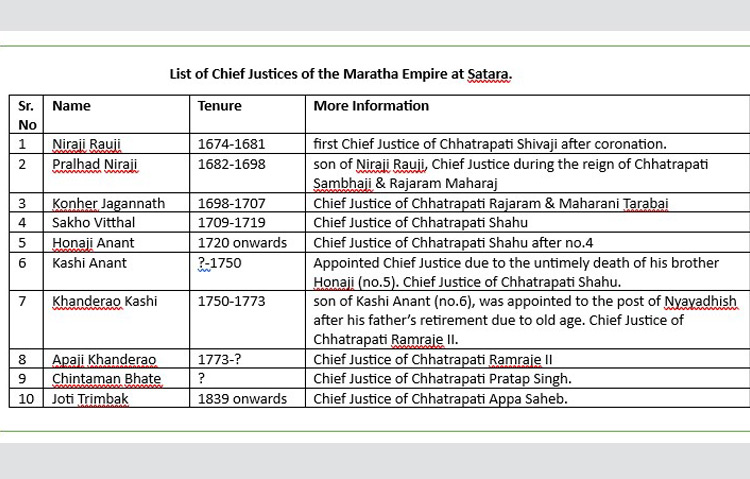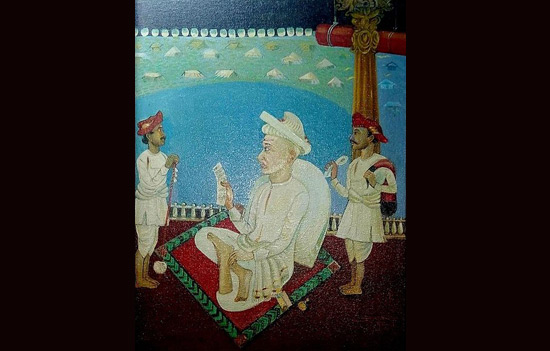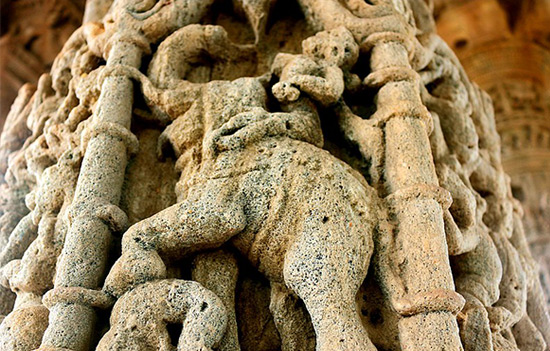- Know about judicial system during Maratha rule and e.g.
of cases
handled from 1630 to 1818. Independence of Judiciary existed. The powerful were
convicted. Delaying tactics were penalized.
दंडो हि केवलो लोकं परं चेमं च रक्षति
राज्ञा पुत्रे च शत्रो च यथादोष सम धृत:
Translated as - It is the power of
punishment alone, when exercised impartially in
proportion to the guilt, and irrespective of whether the person punished is the King's son or an enemy, that protects this world and the next. - Kautilya’s Arthashastra 3.1.42
Judicial Systems in Ancient India
In
ancient India, a King with the help of his ministers and learned Brahmins
acting as jurors was considered last court of appeal on any issue. The cases
were tried according to Dharmashastra like Smritis. However, the cases came to the
King only after going through following phases.
 Evolution of Judicial System
Evolution of Judicial System
To
read in PDF click on PDF 1
The
power to decide village cases was theoretically invested in the whole body of
the village elders. In practice, however, the actual examination of the
parties, their witnesses etc., seems to be delegated to a small sub-committee,
the members of which used to receive a certain honorarium from the fees that was
charged to the disputants. The trials were usually held in the village temple,
holy precincts of which could supposedly stifle any promptings to dishonesty in
the mind of parties and witnesses. All the councils except the village council had
a member appointed by a King to keep track of recordings.2
The evidence can be all or any of the following-‘लिखितभुक्तसाक्षींनीशी’ which roughly translates to लिखित (Documents) भुक्त (Under
possession) and साक्षीं (Witness) नीशी (proved the
case with the help of one or more of these methods).
Even after going through all the phases, if one of the aggrieved parties felt that the decision was not proper or pending due to insufficient evidence, then in such a situation it can perform a ‘Divya’ (Ordeal). The presence of the government officer according to the level of the assembly was absolutely necessary for such trials.
Most of the ‘Divyas’ were performed at religious places and the party which successfully performed the process like taking out heated piece of metal from boiling oil or carrying a red-hot metal ball for a particular distance without injuring itself was considered true and the decision went in his favour.
Divyas
like Kriya or Bel-Bhandara (Holy Bel & turmeric applied to Bhagwan Shiv),
were very rarely invoked as the general belief at that time was that any false
utterance or oath-taking in such a sacred environment would have serious karmic consequences. During the reign of
Chhatrapati Shahu, a witness who testified falsely is said to have died within
a month of performing Kriya.3
 Various types of Ordeals listed.
Various types of Ordeals listed.
To
read in PDF click on PDF 4
Most
of these methods of performing Divya in extreme situations were ancient and continued
throughout the Maratha Empire.
Judicial system during the Medieval
Era
After
the Islamic onslaught, the judicial structure also underwent a change. Hindu
civil disputes were solved as in earlier periods. However, when criminal and
civil cases had one party being a Muslim the case was invariably tried by
Majlis presided by a Qazi and according to Sharia.
Corruption and bribery
played an important part in administration of justice. Only those
could expect to have justice who either had money to bribe or influence. As
there was no written law, there was great scope for discretion and consequently
corruption and favoritism. It is true that an appeal could be taken to the
Emperor, but in most cases, this right came to nothing as the journey to the
capital was long and expensive.5
Also, in ‘The law of evidence’ the burden of proof was heavily stacked against a defendant. For example, no Muslim could be given capital punishment on the evidence of an infidel. Evidence of two women was regarded as being equal to that of one man. Again, evidence was to be direct, and not circumstantial like to convict a man for rape, it was necessary to have four male witnesses who would swear that they had actually seen the accused in the very act of committing the offence.6
Twisting
of law was rampant and appealing against it was very difficult for e.g. under
Shah Jahan marriage of Muslim females to Hindu
males and their conversion to Hinduism, was banned in 1634. The
punishment for such a person was conversion to Islam or death.7 During Aurangzeb’s reign, the quality of justice declined further. In many civil and criminal cases, the offender escaped punishment simply by conversion.
A
few indicate examples are Mihir Chand and Gajpat Kambu who were jailed for
financial irregularities; Udairaj who was suspected in murder of Mirza Raja Jai
Singh; Bhudhar Shiqdar who tried to stop conversion of Hindu lady was jailed,
and released immediately after their conversion.8
Evolution of Judicial systems under
the Maratha Empire
Earlier, many of the disputes in his fief were resolved by young Shivaji Raje with the help of elders like Maharani Jijabai and Dadoji Konddev. But as the Hindvi Swarajya started gaining ground, he realized that for the common man, coming all the way from far-flung provinces to the King’s court was expensive and time-consuming (as King will have limited time). The process itself would become a torture.
Hence
at the time of his coronation as a Chhatrapati, Shivaji Maharaj revived the
age-old tradition by creating two separate posts in his Ashtapradhan Mandal
(Council of Eight Ministers) viz. Nyayadhish
& Panditrao for efficient
dispensation of justice.
Nyayadhish (Chief Justice) should have jurisdiction over all suits in the kingdom and should try them according to the principles laid down by Dharma (Law). He should add the word 'Sammat’ (approved) to the judgment deed.
Panditrao was to act as a supreme authority (apart from Chhatrapati) to decide on religious affairs, as a protocol officer to receive various learned and pious men coming to meet the king, to check whether various rituals like yagnya and shanti were being conducted on the king’s behalf and most importantly to resolve religious disputes according to Hindu dharma shastra, document it for reference and to facilitate reconversions of those who were forcibly converted earlier. This would nullify the supreme position held by Qazi’s during earlier Islamic kingdoms.9
Moreshwar
Panditrao held this position from 1674 to 1688. After 1691, this position was
given to Shrikaracharya Kalgaonkar by Chhatrapati Rajaram.
 Chief Justice under Chhatrapati.
Chief Justice under Chhatrapati.
To
read in PDF click on PDF 10
Most
of the cases in the latter half of the 18th Century were resolved at
Pune under the Peshwas. Only if one of the aggrieved parties approached the
Chhatrapati then a de-novo trial was held at the court.
 Chief Justice based in Pune.
Chief Justice based in Pune.
To
read in PDF click on PDF 11
Here is a brief description of the cases handled during the
period 1630-1818.
For more details you can check the reference given at the end of each case.
Two of the most celebrated cases in the history of the Marathas are – The first being, after the death of Chhatrapati Shivaji, Maratha nobles were split into camps of Maharani Soyarabai or Yuvraj Sambhaji. Many of the nobles who supported former in this phase were incarcerated by Prince Sambhaji but were released later before coronation with a full pardon considering their loyal service to Swarajya and concern that such experienced nobles shouldn’t be executed for supporting Soyarabai.
But a year later some of the major nobles like Ananji Datto, Rahuji Somnath, Hiroji Farzand, Balaji Avaji allegedly tried to conspire with exiled Prince Akbar (Aurangzeb’s son), kill Chhatrapati Sambhaji and place his younger step-brother Rajaram on the throne. At that point he had no choice but to execute them under the charges of treason.
 Chief Justice
Ramshastri.
Chief Justice
Ramshastri.
The
second case was the murder of Narayanrao Peshwa at his own palace in August
1773 by Gardi (French-Garde- Protection troops) due to alleged payments issue.
Sensing the gravity of the situation, Chief Justice Ramshastri personally
investigated the case and unraveled the conspiracy. At Alegaon, where Raghunathrao (Peshwa’s uncle) received robes of Peshwa from Chhatrapati Ramraja-II in October 1773 and held his first court, Ramshahstri declared his judgment that Raghunathrao himself was the chief culprit and planned the whole affair to seize Narayanrao and declare himself as Peshwa.
A
total fifty key conspirators were charged for Rajhatya, Streehatya, Gauhatya, and Brahmahatya (killing of king i.e., treason, lady, cows, and Brahmins).
An enraged Raghunathrao dismissed Ramshastri but now, many of the
administration and the public refused to accept him as the legal head of the
State.
A
council known as the Barbhais (twelve
comrades) soon came to be formed, who expelled Raghoba from his position, and
Madhavrao-II, an infant born to Gangabai (widow of Narayanrao Peshwa) was
declared Peshwa by Chhatrapati Ramraja II in 1774.13
These
cases show that in the Maratha Empire even the highest offices of the state,
including those of a Peshwa, could be tried and sentenced according to their
crime.
 Execution by elephant from Surya Mandir at Modhera, Gujarat (Credit: Rupesh Sarkar)
Execution by elephant from Surya Mandir at Modhera, Gujarat (Credit: Rupesh Sarkar)
Other
notable cases are -
1. Destruction of
property of criminals is certainly not a new phenomenon.
An
interesting example-Balaji
Patil of Amalner murdered his brother in connection with a dispute regarding
the Patilki watan, imprisoned his family, took possession of the village fort,
and refused to pay Government taxes. The people of the village also declined payment
of revenue. To establish a deterrent, orders were issued to Harbaji Pandurang
for the demolition of fort by the bombardment with the help of 2 canons and 100
soldiers, and the capture of the Patil. (PD2-BBP2-P81)
2. Deliberately hiding or tampering with
evidence was considered a very serious crime.
For example, a butcher killed a cow in Pune, which was prohibited by law but the investigating officer took a bribe to misdirect the investigation and tried to pass this off as bull’s meat brought from outside. The investigating officer was not only relieved from his post but also fined, excommunicated, and ordered to perform Kashi yatra as penance. (SPD22-P223), Similarly, Daud Shah Fakir was fined Rs 60 for killing a cow. (SPD22-P227).
3. Religious persecution was very strictly
dealt with.
Sayed
Abubakar Pirzade was given Mankeshwar village (most probably during Mughal
regime). The Pirzada has started religious persecution of Hindus and various
complaints about him like throwing bones at Brahmins while they are dining,
molesting womenfolk who were drawing water from the well, stone-pelting on the
Hindu religious processions passing through village streets, deliberately
butchering cows at Hindu religious places and grabbing farms and fields.
Hence,
orders were sent to arrest Pirzada, attach his property, and deny other rights
like revenue collection. Also, orders were issued to local officers to create a
permanent post at Manakeshwar village and assure villagers that they will not
be persecuted for following Hinduism. (SMP3-P1007)
4. Social justice was also a critical
factor.
For
example, when carpenters and blacksmiths of village Pohri took objection to
taking the bride and bride-groom of Potter caste on horseback, the objection
was overruled and the carpenters & blacksmiths who started the disturbance
were heavily fined. (SMP3-P1023)
To
read more cases click on PDF
Key to cases
SSS2-L
-Shiv Charitra Sahitya-Volume No.- Letter No.
SPD-
Selections from Peshwa Daftar-Volume No-Point No.
SCP-
Shivcharitra Pradip-Pg No.
PD2-BBP2-P79-
Peshwa Daftar (Vad)-Balaji Bajirao Peshwa-Point No.
M1P-
Madhavrao 1 Peshwa-Point No.
SMP-P-
Sawai Madhavrao Peshwa-Volume No.- Point No.
Conclusion
The
Judicial System of the Marathas was inspired by ancient Indian ethos. At the
same it took into consideration the changed contemporary situation.
In
case of deliberate
delaying tactics
like being regularly absent at the trial or not providing required documents
without due reasons, the decision would go directly in favor of the other
party. This also curbed the malpractices like endless delay, bribing, or
eliminating the witnesses.
Independence
of the judiciary
was also not a new phenomenon, as we can check that Ramshastri (Chief Justice) has
taken it in writing from Sakharam Bapu and Nana Fadanvis about non-interference
by the executive.
The
fact that the highest echelons of power (Raghunathrao-Peshwa’s uncle) could be tried and
justice was provided by due process speaks volumes about the systems
implemented by the Maratha Empire.
To read all
articles by author
To read all
articles on Maratha History
References
1. Altekar, A.S., Rashtrakuta &
Their Times, Pg- 210 & Gune, V.T, The Judicial System of The Marathas, Pg 9,
21, 31.
2. Altekar, A.S., Rashtrakuta &
Their Times, Pg 210-11.
3. Gune, V.T, The Judicial System of The
Marathas, Pg-96.
4. Ibid, Pg 91.
5. Acharya. A, Court System in Mughal
Period. Pg 6.
6. Ibid, Pg 7.
7. Bisati A.A., Sheikh Ahmad Sirhindi’s thought & its impact on development of Sufism, Pg 228.
8. Khare, G.H., Aitihasik Farsi Sahitya 6,
Pg 32,33 & Lohogaonkar S., Aurangzeb-Whitewashing Tyrant, Distorting
Narrative, Pg 31, 60.
9. Sardesai G.S., Marathi Riyasat-Part
1, Pg 368.
10. Gune, V.T, The Judicial System of
The Marathas, Pg 33-34.
11. Ibid, Pg 46.
12. Gokhale, K., Shivputra Sambhaji, Pg
72-92.
13. Sardesai G.S., New History of
Marathas-Pg 30-33; & Selections from Peshwa Daftar-Vol 5, L49, 54, 57, 58;
Historical letters L230.